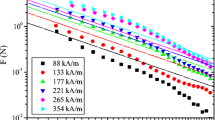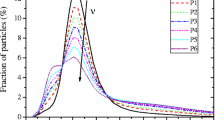Abstract
In this manuscript, we address the long-standing question of whether a single theory for model plastic fluids is suitable to deal with the unidirectional compression problem in magnetorheological (MR) fluids. We present an extensive experimental investigation of the performance of MR fluids in slow-compression, no-slip, constant-volume squeeze mode under different magnetic field strengths (0–354 kA/m), dispersing medium viscosities (20–500 mPa·s) and particle concentrations (5–30 vol%). Normal force versus compressive strain curves reasonably collapse when normalizing by the low-strain normal force. Deviations from the squeeze flow theory for field-responsive yield stress fluids are associated to microstructural rearrangements under compression in good agreement with the so-called squeeze strengthening effect. Yield compressive stresses are found to scale as \(\sim \eta^{0.33\, }\phi ^{2.0\, }\)H2.0.





Similar content being viewed by others
References
Andablo-Reyes E, Hidalgo-Álvarez R, de Vicente J (2010) A method for the estimation of the film thickness and plate tilt angle in thin film misaligned plate–plate rheometry. J Non-Newton Fluid Mech 165:1419–1421
Andablo-Reyes E, Hidalgo-Álvarez R, de Vicente J (2011) Erratum to “A method for the estimation of the film thickness and plate tilt angle in thin film misaligned plate–plate rheometry. J Non-Newton Fluid Mech 165:1419–1421 (2010)”. J Non-Newton Fluid Mech 166:882–882
Carlson JD (2007) MR fluid technology—commercial status in 2006. In: Gordaninejad F, Graeve OA, Fuchs A, York D (eds) Proceedings of the 10th international conference on electrorheological fluids and magnetorheological suspensions. World Scientific, Singapore, pp 389–395
Chu SH, Lee SJ, Ahn KH (2000) An experimental study on the squeezing flow of electrorheological suspensions. J Rheol 44(1):105–120
Covey GH, Stanmore BR (1981) Use of the parallel-plate plastometer for the characterization of viscous fluids with a yield stress. J Non-Newton Fluid Mech 8:249–260
de Vicente J, Klingenberg DJ, Hidalgo-Álvarez R (2011a) Magnetorheological fluids: a review. Soft Matter 7:3701–3710
de Vicente J, Ruiz-López JA, Andablo-Reyes E, Segovia-Gutiérrez JP, Hidalgo-Álvarez R (2011b) Squeeze flow magnetorheology. J Rheol 55:753–779
El Wahed AK, Sproston JL, Stanway R (1998) The performance of an electrorheological fluid in dynamic squeeze flow under constant voltage and constant field. J Phys D: Appl Phys 31:2964–2974
Ginder JM, Davis L, Elie L (1996) Rheology of magnetorheological fluids: models and measurements. Int J Mod Phys B 10:3293–3303
Gstöttenbauer N, Kainz A, Manhartsgruber B, Scheidl R (2008) Experimental and numerical studies of squeeze mode behaviour of magnetic fluid. Proc IMechE C 222:2395–2407
Havelka KO, Pialet JW (1996) Electrorheological technology: the future is now. CHEMTECH 36:36–45
Klingenberg DJ, Ulicny JC, Smith AL (2007) Effects of body forces on the structure and rheology of ER and MR fluids. Int J Mod Phys B 21:4841–4848
Laun HM, Schmidt G, Gabriel C (2008) Reliable plate–plate MRF magnetorheometry based on validated radial magnetic flux density profile simulations. Rheol Acta 47:1049–1059
Lynch R, Meng Y, Filisko FE (2006) Compression of dispersions to high stress under electric fields: effects of concentration and dispersing oil. J Colloid Interface Sci 297:322–328
Mazlan SA, Ekreem NB, Olabi AG (2007) The performance of magnetorheological fluid in squeeze mode. Smart Mater Struct 16:1678–1682
Mazlan SA, Ekreem NB, Olabi AG (2008) An investigation of the behaviour of magnetorheological fluids in compression mode. J Mater Process Tech 201:780–785
McIntyre EC, Filisko FE (2007) Squeeze flow of electrorheological fluids under constant volume. J Intell Mater Syst Struct 18:1217–1220
McIntyre EC, Filisko FE (2010) Filtration in electrorheological suspensions related to the Peclet number. J Rheol 54(3):591–603
Meng Y, Filisko FE (2005) Unidirectional compression of electrorheological fluids in electric fields. J Appl Phys 98:074901
Olabi AG, Grunwald A (2007) Design and application of magneto-rheological fluid. Mater Des 28:2658–2664
Park BJ, Fang FF, Choi HJ (2010) Magnetorheology: materials and application. Soft Matter 6:5246–5253
Scott JR (1929) Trans Inst Rubber Ind 4:347–347
See H (2003) Field dependence of the response of a magnetorheological suspension under steady shear flow and squeezing flow. Rheol Acta 42:86–92
Stanway R, Sproston JL, Stevens NG (1987) Non-linear modelling of an electro-rheological vibration damper. J Electrostatics 20:167–184
Tang X, Zhang X, Tao R, Rong Y (2000) Structure-enhanced yield stress of magnetorheological fluids. J Appl Phys 87(5):2634–2638
Tian Y, Meng Y, Mao H, Wen S (2002a) Electrorheological fluid under elongation, compression, and shearing. Phys Rev E 65:031507
Tian Y, Meng Y, Mao H, Wen S (2002b) Mechanical property of electrorheological fluid under step compression. J Appl Phys 92:6875–6879
Tian Y, Meng Y, Wen S (2003a) Particulate volume effect in suspensions with strong electrorheological response. Mater Lett 57:2807–2811
Tian Y, Wen S, Meng Y (2003b) Compressions of electrorheological fluids under different initial gap distances. Phys Rev E 67:051501
Wen W, Huang X, Sheng P (2008) Electrorheological fluids: structures and mechanisms. Soft Matter 4:200–210
Williams EW, Rigby SG, Sproston JL, Stanway R (1993) Electrorheological fluids applied to an automotive engine mount. J Non-Newton Fluid Mech 49:221–238
Zhang XZ, Gong XL, Zhang PQ, Wang QM (2004) Study on the mechanism of the squeeze-strengthen effect in magnetorheological fluids. J Appl Phys 96(4):2359–2364
Zhang ML, Tian Y, Jiang JL, Zhu XL, Meng YG, Wen SZ (2009) Compression enhanced shear yield stress of electrorheological fluid. Chin Phys Lett 26(4):048301
Acknowledgements
This work was supported by MICINN MAT 2010-15101 project (Spain), by the European Regional Development Fund (ERDF) and by Junta de Andalucía P10-FQM-5977, P10-RNM-6630 and P11-FQM-7074 projects (Spain). J.A.R.-L. acknowledges financial support by the “Ministerio de Educación: Becas del Programa de Formación del Profesorado Universitario (FPU)” (AP2010-2144).
Author information
Authors and Affiliations
Corresponding author
Rights and permissions
About this article
Cite this article
Ruiz-López, J.A., Hidalgo-Alvarez, R. & de Vicente, J. On the validity of continuous media theory for plastic materials in magnetorheological fluids under slow compression. Rheol Acta 51, 595–602 (2012). https://doi.org/10.1007/s00397-012-0626-x
Received:
Revised:
Accepted:
Published:
Issue Date:
DOI: https://doi.org/10.1007/s00397-012-0626-x




